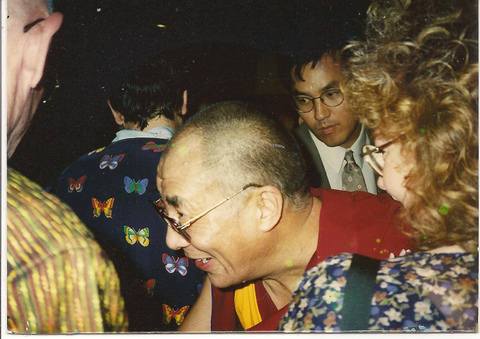“The Church, Depression, and the Death of Matthew Warren,” by Dr. Mark Poindexter, pastor of the First Christian Church of Martinsville, Indiana, followed by a blog post from Reverend Dr. William D. Peterson, a retired Presbyterian Church USA Teaching Elder/ Minister of the Word and Sacrament, who blogs at Still Faith-Full stillfaithfullone@gmail.com.
http://dmergent.org/articles/2013/4/12/the-church-depression-and-the-death-of-matthew-warren
The Church, Depression, and the Death of Matthew Warren
By Mark Poindexter
The suicide of Matthew Warren, Pastor Rick Warren’s twenty-seven year old son, is a reminder of the devastating impact that mental illness can have. Pastor Warren made it clear that his son had suffered a life long battle with depression that had previously included suicidal thoughts.
As a parent, I simply grieve with the Warren’s over this most difficult loss.
As a pastor, I have stood beside parents who have lost a child and have witnessed their deep anguish.
I also saw my mother bury two of her children, my brothers, and the pain of their loss was part of her life every day. The grief over losing a child becomes quite complicated when the child’s death comes at their own hand. Like Matthew, my brother David suffered with mental illness, specifically bi-polar disorder that included severe times of depression. At the age of fifty-four, my brother took his own life. He left behind a wife and three children. Our entire family felt regret and guilt that we were not able to do more to help David. This was especially true for my mother. The fact that David was an adult did not keep her from thinking that if only she had only been able to be with him more and express her love to him better, than he would not have taken his life. I have no doubt that the Warren family has been asking a lot of “What if ” type questions and imagining many “If only” scenarios. I hope with the love and support of friends, the foundation of their faith, and with some understanding about mental illness, they are able to move beyond those questions.
The other aspect of Matthew Warren’s death that touches me is that I have waged a battle with depression myself. It is a battle that at one time took me very close to the kind of dark places that it took Matthew. Those of us who have battled this illness know that it is much more than just “the blues” or “being sad.” It involves a mental, emotional and even physical anguish that seems to suck the life right out of you. Though I thought my time of depression lasted only a few months at most, my wife told me that she saw a change in my behavior that lasted more than two years. My depression affected our relationship; it affected my ability to be a good parent to my children. The truth is since my depression was accompanied by a sense of paranoia it affected my relationship with most everyone around me. For a number of reasons I was able to come through my time of depression and I think I am stronger for it. I would like to share a few of the lesson I have learned.
Having suffered a mental illness is nothing for which one must be ashamed. I have chosen to be honest about my depression with folks in the congregation I serve. I do not dwell on it, but it has found its way into a few sermons and when I am in a pastoral situation with folks who I think might benefit from seeing a therapist, I am willing to share that therapy has been a part of my life. Being honest about my struggle with depression is one way I battle it. It helps me to stay proactive in dealing with it. For many reasons, mental illness – especially depression, carries a stigma in our culture. In seeking to live honestly with my illness, I refuse to let the misunderstandings of others define me.
I have also sought to educate myself about my illness through talking with professionals and a great deal of reading. I have read several books about depression, faith and depression, pastoral leadership and depression, etc., One of the most helpful books, especially as one who provides leadership to others, was Joshua Wolf Shenk’s, Lincoln’s Melancholy: How Depression Challenged a President and Fueled His Greatness. I would highly recommend this book to anyone who has suffered a bout with depression or who simply wants to learn more about the illness. One way this book was helpful was by allowing me to understand that the depression I suffered can also be a path toward gaining wisdom and understanding for others. My illness has helped me to be more compassionate and patient toward those whose joy in life seems to have left them.
An important element in my on-going self-care has been daily physical exercise. When I was in my darkest place, I could barely get myself out of bed and was only up 3-4 hours before I would be back in bed. I knew I would feel better if I got out and exercised but I had absolutely no energy or desire. Finally, a dear friend, who knew my struggle, came to my house and would not leave until I went out for a walk with him. We walked four miles that day and I felt better afterwards – both the physical movement and the supportive companionship started my journey out of that dark place. Since then I have been intentional about exercise. I try to spend at least an hour a day, five to six days a week, exercising. I have learned that this helps not only my physical well-being, but my mental, emotional and spiritual well-being as well.
It is also important for the church to understand that depression is not a sign of someone’s lack of faith. Anyone who reads the Psalms can see that the “dark night of the soul” is honestly, and quite frequently, spoken about in the scriptures. It is important for communities of faith to make safe space for people suffering from depression to share their struggle. One of the most important things we can do is be careful and not turn the Christian faith into nothing other than a fallacy of how to “be happy all the time.” Though we do speak of joy and hope and happiness, we must also speak of sorrow and struggle and anguish, because they too are a real part of the human experience and thankfully, we have scriptures that recognize this reality. For me, dealing honestly with my depression has allowed me to experience the realities of joy and hope in an even deeper way. My faith was instrumental for me making it through my dark night of the soul. For I believe that even in the most difficult days, God was present with me, not simply to take me out of the darkness, but to share it with me.
My prayers go out to the Warren family and to all who have been affected by depression. I wish Matthew had found some way to make it through that night. I know that I do not believe God left him in that moment, nor that God does anything other than receive him now in love.
I do not know if this very brief sharing of my story will be helpful to anyone who will read it. I hope it might. I pray that I never go through a bout of depression like I did, but if I do; I know I have the resources of faith, family and friends to help me through it. I am not glad for the experience, but I am glad for what I have been able to learn about life and myself because of it.
Dr. Mark E. Poindexter has been the Senior Pastor of First Christian Church (Disciples of Christ) in Martinsville, IN since August of 2005. Pastor Mark has been in pastoral ministry since 1989. His area of special interest is ministry to the grieving and he has served as a volunteer Hospice chaplain. His doctoral research was in this area and his project was titled, The Human Search for Meaning: Confronting our Mortality. Pastor Mark has also been heavily involved in community ministries, serving on the board of the Alexandria, Indiana Emergency Relief Fund and Food Pantry for six years. He was also the founding president of the Washington County, Indiana Habitat for Humanity and oversaw the building of their first home. In addition to enjoying preaching, Pastor Mark recently had a sermon published by Guild Press in Keeping the Faith: Best Indiana Sermons in the New Millennium. He and his wife Becky have been married for 16 years and have two children Christopher (13) and Michele (9). Mark’s hobbies include reading, collecting “Lions and Lambs”, and running. He counts it as an accomplishment that he has completed 2 mini-marathons.

